Mackay, Idaho – The town of Mackay is nestled near the base of Idaho’s highest peak, Mr. Borah (standing at 12,662 ft.) and the Lost River Range. In the mid to late 1800’s settlers began to gather in the valley between the Lost River Range (a high mountain range of the Rocky Mountains in central Idaho) and the White Knob Mountains (a group of mountains that are nearly encircled by the Big Lost River).
In 1884, copper mining began at the foothills of Mackay Peak (the highest peak of the White Knob Mountains). By 1901, the town was named after John W. Mackay, a Nevada mining engineer who never visited Mackay but was responsible for funding the establishment of the White Knob Mine.
According to Earl Lockie, a historian from the South Custer County Historical Society, by about 1900, there were thousands of men employed in the Mackay area constructing an electric mining railroad, a huge smelter complex, and extensive mine tunneling. In about 1904, the complete mining operation was converted to a leasing system, with mining done by individuals or small groups of individuals, working independently for themselves leasing the properties and equipment from the company holding patents to the mine property (Empire Mine Co.).
(To enlarge photos – click on the image)
Many Basques were quite likely hired on by lessors needing experienced men. Several of the mining crew pictures in the So. Custer Country Historical Society collections have crew members identified, and some (most likely Basques) are listed as “Spaniards”.
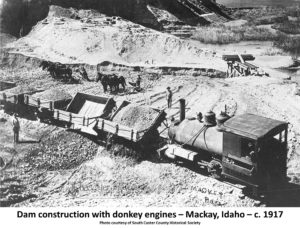 Beginning in 1908 and continuing until 1918, was a large force of men working on construction of the Mackay Dam. The dam holding water of the Big Lost River was constructed by the Utah Construction Co. of Utah.
Beginning in 1908 and continuing until 1918, was a large force of men working on construction of the Mackay Dam. The dam holding water of the Big Lost River was constructed by the Utah Construction Co. of Utah.
The trip from the village of Mackay to the mining activity on the hill was three and a half to four miles. Many chose to live on the “Hill”, most in very crude huts, dugouts or shanties on the steep hillside as evidenced by the photos depicting the mining operations and living conditions at White Knob.
Throughout the years, the industries of active mining (1901-1940’s) and sheep raising (1900-1950’s) provided opportunities for Basque immigrants in the area. It is likely that many of the Basque population in the area opted to establish a business or residence in the Mackay area.
The only name the So. Custer County History Society  has a record of is the Uresti’s and their residence (boardinghouse) on Spruce Street. It still stands today, the home of the “Bear Bottom Inn” restaurant. [Note: Some members of the family spelled their last name Uresti while others spelled it Urresti.]
has a record of is the Uresti’s and their residence (boardinghouse) on Spruce Street. It still stands today, the home of the “Bear Bottom Inn” restaurant. [Note: Some members of the family spelled their last name Uresti while others spelled it Urresti.]
Flora Urresti (Uresti) Aspiazu, in a report written in 2008 entitled, “Basques in Custer County,” attempts to document the history of the Basques in the Custer County area.  Flora’s parents were immigrants and she was raised in the Mackay area. The Basque Museum & Cultural Center is thankful to Flora for these written memories as they help to document the presence of Basques in Custer County. The following is the report, as presented by Flora Urresti Aspiazu, with the modification of additional notes by Basque Museum & Cultural Center staff placed in brackets [ ].
Flora’s parents were immigrants and she was raised in the Mackay area. The Basque Museum & Cultural Center is thankful to Flora for these written memories as they help to document the presence of Basques in Custer County. The following is the report, as presented by Flora Urresti Aspiazu, with the modification of additional notes by Basque Museum & Cultural Center staff placed in brackets [ ].
The date when the first Basques arrived in Custer County is not known. The beginning of World War I (1914) brought an influx of Basques to the county.
The community of Basques in Custer Country represented Basques from the four Basque provinces in Spain: Araba, Bizkaia, Gipuzkoa, and Nafarroa. There were also a number of Basques from the French side of the Pyrenees Mountains.
Although they spoke Basque dialects from their respective provinces, they understood each other. Born in Challis, Idaho on February 26, 1920, Flora spoke Basque as her first language. [Flora’s parents and four brothers lived in the White Knob mining community, which was located in the mountains four miles above the town of Mackay. In 1919 the family moved to Challis and in 1921 moved to Mackay where Flora grew up and her parents operated a boardinghouse]. 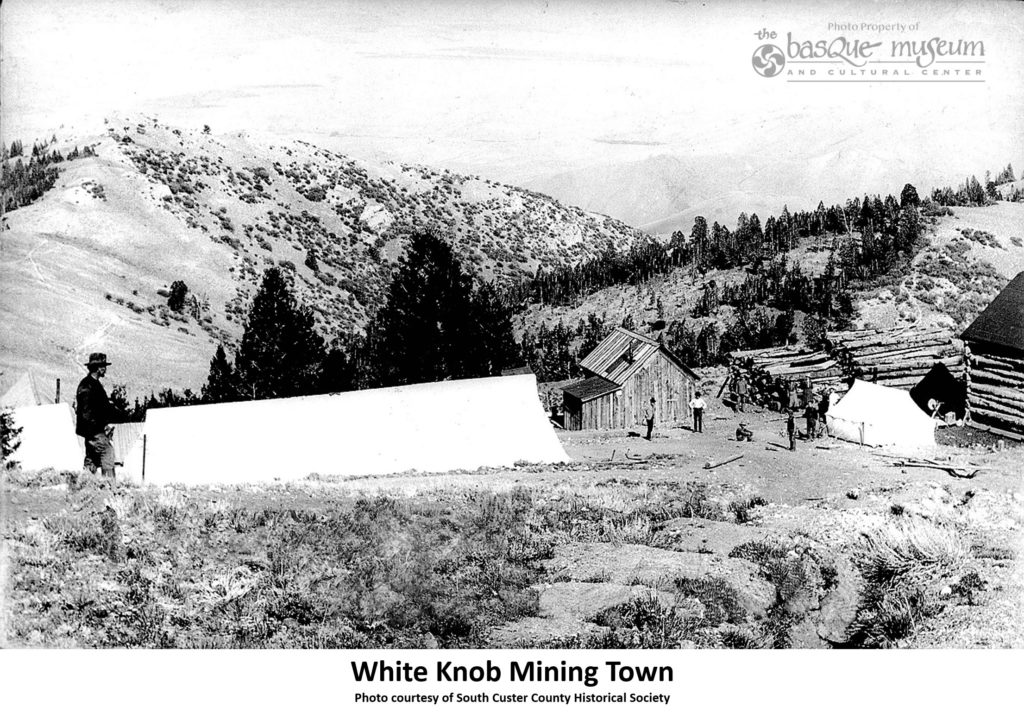 She felt that growing up in a Basque boardinghouse hearing and understanding the various dialects was enriching.
She felt that growing up in a Basque boardinghouse hearing and understanding the various dialects was enriching.
Flora believes that the influx of Basques to the area was due to job opportunities in three areas:
Flora Urresti [Uresti] writes that, “the majority of the Basques were attracted by the mining industry and that those men were experienced miners. Some of them had been employed in coal mines in Pennsylvania, Price, Utah and Rock Springs, Wyoming. 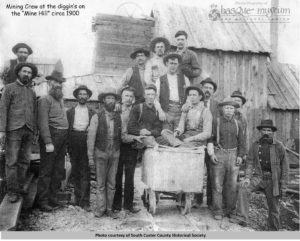 Some of the men had worked in gold mines in Ketchikan and Juneau, Alaska. Other former places of employment were mines in Montana, Nevada, California, North Idaho, and in Silver City and Delamar in Owyhee County, Idaho.” Flora relates that the stories of their travels and experiences were “fascinating.”
Some of the men had worked in gold mines in Ketchikan and Juneau, Alaska. Other former places of employment were mines in Montana, Nevada, California, North Idaho, and in Silver City and Delamar in Owyhee County, Idaho.” Flora relates that the stories of their travels and experiences were “fascinating.”
Flora Urresti’s niece, Connie Urresti researched Basque Miners in Whiteknob and Mackay in Custer County, Idaho using WWI draft records, Empire Mine Records and Lessor Register Records from the So. Custer County Historical Society. She created the spreadsheet linked below to track these men, where they worked and where they were from.
 Flora Urresti [Uresti], in her memoirs, states the following:
Flora Urresti [Uresti], in her memoirs, states the following:
“The Bayhorse and Livingston mines were located in the White Cloud Mountains area. The Clayton Silver Mines were located on the East Fork of the Salmon River area. Other mines were located in Goldberg and Patterson in the Pahsimeroi Valley. The Basques employed in the Bayhorse, Livingston, Clayton, Goldberg and Patterson mines were mostly single men. 
The largest mining operations were located in the Mackay area. The Empire Mining company offices and smelter were located about a mile west of Mackay. Their mine was located four miles west of Mackay in the Pioneer Mountains near the mining community of White Knob.
The U.S. Mining and Smelting Company of Salt Lake City, Utah operated lead mines in the White Knob area. Their ore was trucked to Mackay and then shipped, by rail, to Utah smelters.
The ore from Clayton, Bayhorse, Livingston and Patterson was trucked to Mackay and from Mackay was shipped by rail to Utah smelters.
The images below are from pay record books from the Empire mines. You will see several Basque names in the entries (Menchaca, Saguadi, Serriga, Sorrosua, Icasuriga, Argoitia, Uresti). For more images of the record books, see the photo gallery.
According to the writing of Flora Urresti [Uresti], Basques were employed by the following sheep companies:
 The B. Drake Company was located sixteen miles south of Challis. The D.B. Drake operation was the largest sheep operation in Custer County with summer ranges in the White Cloud Mountains.
The B. Drake Company was located sixteen miles south of Challis. The D.B. Drake operation was the largest sheep operation in Custer County with summer ranges in the White Cloud Mountains.
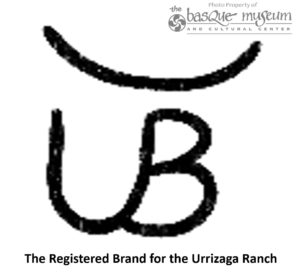 The Urrizagas also lived in Elko, Nevada and Buhl, Rigby and Pocatello, Idaho
The Urrizagas also lived in Elko, Nevada and Buhl, Rigby and Pocatello, Idaho
During the time that Bolen Uresti (with his first wife Patricia “Pat Beverly” Dodge Uresti and then second wife, Helen Trevino Huggins Uresti) owned the ranch, he was named “Grassman of the Year” in 1969.  Bolen sold the ranch in 1978-1979 to John Landa and his son, Marty Landa, who actually lived on and operated the ranch whereas Phillip Yribar and Pete Elia never lived on the ranch. After two years, ownership challenges lead to the return of the ranch to Bolen Uresti sometime around 1981. Sulphur Creek Ranch was no longer owned by Basques after about 1983-1985.
Bolen sold the ranch in 1978-1979 to John Landa and his son, Marty Landa, who actually lived on and operated the ranch whereas Phillip Yribar and Pete Elia never lived on the ranch. After two years, ownership challenges lead to the return of the ranch to Bolen Uresti sometime around 1981. Sulphur Creek Ranch was no longer owned by Basques after about 1983-1985.
Source: John Urresti – 2.19.2021




Flora Urresti [Uresti] writes that the largest concentration of Basques in Custer County was in Mackay and in White Knob. The Basque boardinghouse played a very important role in both the lives of the single men and the families.  The boardinghouse was not only a home for the single men, it was a gathering place for the families to socialize, to retain their identity, their language and preserve their customs. The boardinghouse was a part of the Old World home in the New World. In 1914 and 1915 Basque families joined numerous other ethnic families to make their homes on the hillsides of White Knob in order to be close to the workplace.
The boardinghouse was not only a home for the single men, it was a gathering place for the families to socialize, to retain their identity, their language and preserve their customs. The boardinghouse was a part of the Old World home in the New World. In 1914 and 1915 Basque families joined numerous other ethnic families to make their homes on the hillsides of White Knob in order to be close to the workplace.
Elquezabal boardinghouse In 1914 there were two boardinghouses in Mackay. One was operated by Jose Elquezabal and his wife. Mr. Elquezabal was employed by the Utah Construction Company. Mrs. Elquezabal passed away in the early 1920s and the family moved to Pocatello.
Diaz boardinghouse The second boarding house was owned by a family whose name is not remembered. The wife’s name was Beatriz. [The 1920 Census shows the Diaz Family – wife’s name is Beatriz. Emil, head of family, identified as a miner.] They moved from Mackay in the mid-1920s.
Yriondo, then Uresti (Urresti) Boardinghouse Justo Yriondo and Isabel Unamuno [NOTE: Utah death records list her name as Ysabel Sarria] met each other in Shoshone. Justo, who was from the province of Gipuzkoa [and] worked on a sheep ranch. Isabel was from the province of Bizkaia. She worked as a maid in the home of a physician. Isabel learned to speak fluent English. After their marriage, Justo and Isabel moved to White Knob in 1916. Their daughter Helen was born in White Knob in 1917. The family moved to Mackay in 1917 where they built a boardinghouse. Justo continued working in White Knob and Isabel operated the boardinghouse.
In the summer of 1921 the Yriondos leased the boardinghouse to Polonio and Maria Carmen (Bengoechea) Uresti. The Yriondos moved to Park City, Utah where they built another Basque boardinghouse. Justo worked in the Park City mines.
Polonio Urresti [Uresti] and Maria Carmen Bengoechea,  who were from the province of Bizkaia, met in a Basque boardinghouse in a mining town in Owyhee County. Polonio worked in the mine and Maria Carmen worked as a maid in the boardinghouse. After their marriage in 1912, they lived in Delamar, Idaho until the mine closed in early 1913. They moved to Mountain Home where sons Bolen and Marcel were born. When the family lived in Mountain Home, Polonio worked for a sheep company.
who were from the province of Bizkaia, met in a Basque boardinghouse in a mining town in Owyhee County. Polonio worked in the mine and Maria Carmen worked as a maid in the boardinghouse. After their marriage in 1912, they lived in Delamar, Idaho until the mine closed in early 1913. They moved to Mountain Home where sons Bolen and Marcel were born. When the family lived in Mountain Home, Polonio worked for a sheep company.
In the spring of 1915, the family arrived in Mackay to make their home in White Knob. Their sons Martin and Paul were born in White Knob.  The family doctor advised Polonio to leave the mines for health reasons. In 1919 the family moved to Challis to work for Dr. Phelps’ Sheep Company. Flora Urresti was born on the Phelps Ranch. The log home where she was born was still on the ranch in 2008.
The family doctor advised Polonio to leave the mines for health reasons. In 1919 the family moved to Challis to work for Dr. Phelps’ Sheep Company. Flora Urresti was born on the Phelps Ranch. The log home where she was born was still on the ranch in 2008.
In the summer of 1921, the Uresti [Urresti] family moved to Mackay where Polonio and Maria Carmen leased the Yriondo boardinghouse and Polonio returned to White Knob to work in the mines. Mary Uresti [Urresti] was born in the Yriondo home. 
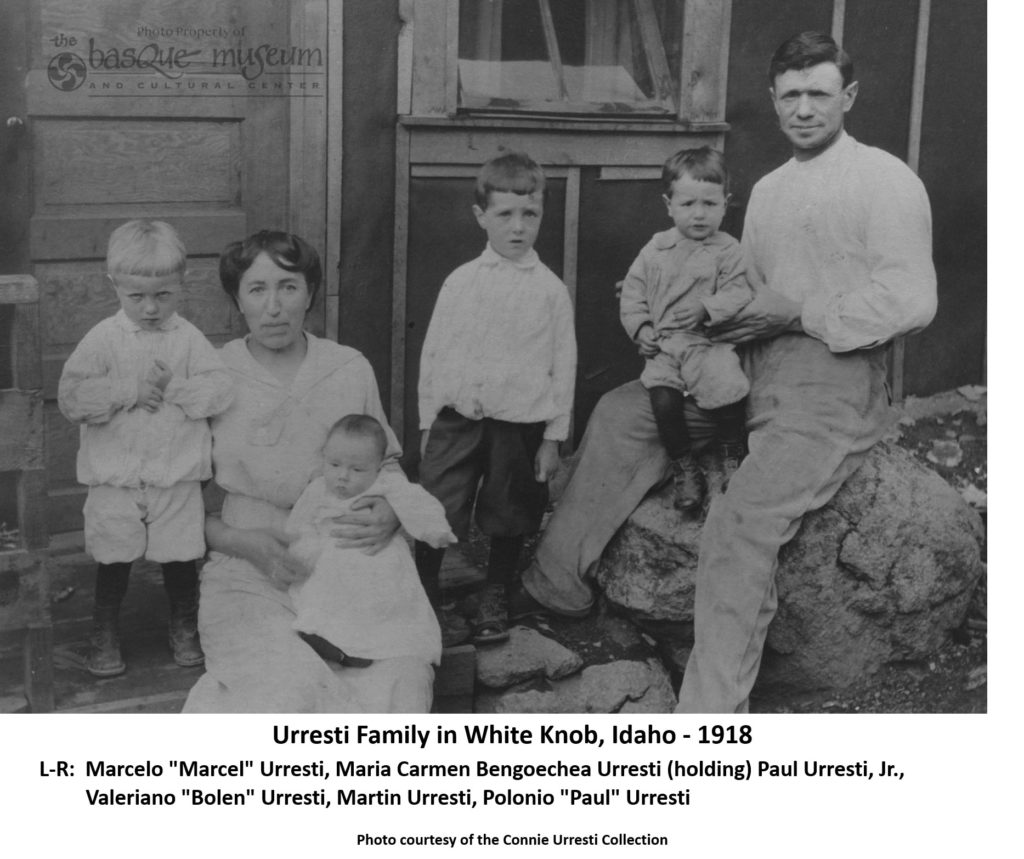
Soloaga. In the summer of 1926 the Soloaga family of Shoshone purchased the Yriondo property. Domingo Soloaga and his wife Antonia owned a boardinghouse in nearby Shoshone, Idaho. They partnered with a cousin from the Soloaga family to purchase the boardinghouse in Mackay. 
Polonio & Mari Carmen (Bengoechea) Uresti [Urresti] then renovated the rooming house behind the Custer Hotel. All the boarders from the Yriondo home moved with them.Gloria Uresti [Urresti] was born in this home. 
In 1926 there were many single Basque men boarding in the company boardinghouse in White Knob. Again there were two boardinghouses in Mackay. So the single men moved to Mackay to live in the Uresti [Urresti] and Soloaga homes.
The following information was provided by Flora Urresti in a paper written in 2008 entitled, “Basques in Custer County”. Modifications and additional notes by the Basque Museum & Cultural Center staff are placed in brackets [ ].
The Esteban and Julia (Elordi) Aspiazu Family
Mr. Aspiazu was from the province of Gipuzkoa. When he was single he served in the Spanish Cavalry in Cuba in the Spanish American War. After the war, he returned to Gipuzkoa. He was restless. He and a group of Basques from Gipuzkoa and Bizkaia crossed the Atlantic Ocean to Nova Scotia, traveled across Canada and went to Alaska. They worked in the gold mines in Ketchikan and Juneau. After a few years he returned home to work with his father, who was a livestock buyer. They traveled throughout Gipuzkoa and Bizkaia. In Bizkaia he met and married Julia Elordi. [They had a son, James while living in the Basque Country.]
Once again the mines beckoned and in 1910 Esteban found his way to Delamar, Owyhee County, Idaho where numerous Basques were working in the mines. (link to Delamar, Idaho)
In 1911, Julia (Elordi) Aspiazu and [their son], James Aspiazu joined Esteban Aspiazu in Delamar. Their daughter, Gloria, was born in Delamar. When the mines closed, they moved to Jordan Valley, Oregon where their daughter, Estella, was born. The family also lived in Boise for a short time. In 1915 the family moved to White Knob where Esteban was employed in the U. S. Mining and Smelting lead mines. Their daughter, Angela, was born in White Knob.
Transportation from Mackay to White Knob had improved. Families moved to Mackay and the men could travel back and forth to work in White Knob. The Aspiazus moved to Mackay in 1919. Their daughter, Pilar, who died in infancy, was born in Mackay. Pilar Aspiazu is buried in Mt. McCaleb Cemetery [in Mackay, Idaho].
The family moved to Bingham Canyon, Utah in 1926 where Esteban continued to be employed in Bingham Canyon by the U.S. Mining and Smelting Company. In later years, [their oldest daughter], Gloria returned to Idaho where she met and married Pedro Batis who was from Bizkaia. They made their home in Ketchum. Gloria passed away in 1993.
When [their oldest son], James Aspiazu retired from Kennecott Copper Corporation, he and [his wife] Flora Urresti Aspiazu made their home in Boise, Idaho. James passed away in 1998. Estella Aspiazu Zubizarreta was living in Colorado and her sister Angela Aspiazu Arriz was living in Bingham Canyon, Utah in 2008.
The Eduardo Osoro and Santa (Satica) Osoro Family
Eduardo Osoro [and Santa Maria Santa Satica/Zatica] Osoro, who [were] from Gipuzkoa, had been living in Nevada. They lived in White Knob for several years. Then they and their children moved to Mackay where their son, John, was born. In the early 1920’s they moved to Bingham Canyon, Utah to work for the U. S. Mining and Smelting Company.
The Enrique Zabala and Mariana (Arrascada) Zabala Family
In 1915 the Enrique and Mariana (Arrascada) Zabala [Savala] family arrived in White Knob from Rock Springs, Wyoming where Mr. Zabala [Savala] had worked in the coal mines.  Their daughter, Louise, was born in White Knob. In the early 1920’s the family returned to Rock Springs.
Their daughter, Louise, was born in White Knob. In the early 1920’s the family returned to Rock Springs.
Louise Zabala [Savala] met her husband, Jean Pierre Etcheverry, who is French Basque, in a Basque boardinghouse in Ogden, Utah. They are now sheep ranchers in Rupert, Idaho. [They had one son, Henry Etcheverry and a daughter, Jean (Etcheverry) Chisholm].
Eugenio Gabiola and Maria [Laca Arritola] Gabiola Family
The Eugenio and Maria Gabiola family lived in White Knob until 1918. They worked hard, saved their money and returned to Bizkaia. [They had eleven children together: six boys (John, Louie, Emilio, Jose, Eusebio, Henry and Rufino) and four daughters (Anna, Concha, Petra and Paula)] In the 1930’s some of their children who had lived in White Knob, returned to Idaho.
Recently Henry Gabiola who was born in White Knob, passed away in Vale, Oregon on March 23, 2006. [According to his obituary, in 1941 Henry was drafted into the military, fighting in the Pacific Theater. After his discharge in 1945 he worked as a sheepherder. He married Edurne Arriaga-Marcquerquiaga in 1951 and moved to Hell’s Canyon to raise sheep. After the Brownlee Dam was built in 1957, he and his family moved to Ontario and farmed and raised cattle. Henry and Edurne had five children: four daughters ( Vicki Gabiola Miesbach, Anna Gabiola Sullivan, Josephine Gabiola Hartwell and Rosie Gabiola Debban) and one son (Danny Gabiola).]
 Henry’s brother, Eugenio [Eusebio], and his family live in Kuna, Idaho.
Henry’s brother, Eugenio [Eusebio], and his family live in Kuna, Idaho.
The Jose Bengoechea and Flora Urresti [Uresti] Bengoechea Family
Jose Bengoechea (brother to Flora Urresti [Uresti] Aspiazu’s mother) and his wife, Petra, who were from Gipuzkoa, lived in Mackay in 1915. They later lived in Pocatello for a number of years. The family returned to Gipuzkoa. Jose Bengoechea returned to Custer Country to work for Felipe Yribar. He worked for a number of sheep companies in Idaho. When he retired, he returned to Gipuzkoa. Their son, Joseph, who was born in Mackay, returned to Idaho in 1936. In later years he was employed by Idaho Power Co. He and his family made their home in Boise and Twin Falls.
The Pedro and Teadora Anselmo Family
Pedro and Teadora Anselmo and their son, Maximo, left the Basque Country to live in Argentina for several years. They found their way to Mackay where they lived in the Urresti[Uresti] boardinghouse. Mr. Anselmo worked in White Knob. They returned to Bizkaia in the mid-1920s. Maximo returned to Mackay in the mid 1930’s and worked for the D. B. Drake Sheep Co. After a few years he moved to Blackfoot.
The Louis and Josephine Giraud Family
Josephine Giraud was French Basque. Josephine was a dear friend of the Urresti family. She and her husband, Louis, who was French, had no children. The Urresti children spent many happy hours on the Giraud ranch below Mackay. Josephine passed away in 1928. Louis remained on the ranch for several years. He then sold the ranch and made his home with the Urresti family until his death. Josephine and [Alfred] Louis’ final resting place is Mount McCaleb Cemetery in Mackay, Idaho.
The Valentin Solosabal and Maria Aberasturi Solasabal Family
Valentin and Maria (Aberasturi) Solosabal and their children came to Custer Country before 1920 to work for the Bengoechea Sheep Company. Mr. Bengoechea had several sheep ranches in Mountain Home. He was purchasing the D. B. Drake Sheep ranch on contract. When Bengoechea returned the ranching operation to D. B. Drake, the Solosabal family moved to Mackay. The family lived in Mackay on a farm where Mr. Solosabal was employed. [May, 1942 WWII draft registration indicates he was working for John Arambarri and in 1962 for the John Garro Sheep Ranch (certificate of death).] In the mid 1920’s they moved to Rupert to make their home. [They had six children together: Valentin “Val” Solosabal, Sandy Solosabal, Raymond Solosabal, Mary Solosabal Foster, Paul Solosabal and Crisencia Solosabal.]
The Ramon and Maria Ytuarte Family
Ramon Ytuarte of Mountain Home was Bengoechea’s foreman on the D. B. Drake ranches. Ramon and his wife, Maria were frequent visitors to Mackay. [Ramon Ytuarte is listed as a farmer and stockman working for himself with his wife living at 453 Arthur in Pocatello on his 9.11.1918 WWI Draft Registration Card]. Prior to returning to Mountain home in the early 1920s, the Ytuarte’s lived in Mackay for a while. Mr. Ytuarte’s younger brother was killed in an automobile accident on Willow Creek Summit near Challis. He is buried in Mount McCaleb Cemetery in Mackay, Idaho.
The Simon and Pearl Guisasola Family
Simon Guisasola and his family were old timers in Mackay. [According to immigration records, he came to the United States to work as a carpenter at the age of 18 in September of 1906.] Simon worked in White Knob. After the 1929 Depression they moved to Bellevue where they operated a tavern. [According to 1940 U.S. census records, Simon and Pearl had five children: 4 sons (Sammie, Frank, Lewis and Charles and one daughter, Marie).]
The Eulogio Arrien and Severiana Urtisberea Arrien Family
Eulogio and Severiana (Urtisberea) Arrien met in Shoshone, Idaho. Eulogio was from Bizkaia and Severiana from Gipuzkoa. They lived in Hailey where Mr. Arrien was employed in the Triumph Mine. In 1928 they and their son, Henry, arrived in Mackay. Mr. Arrien worked in White Knob. Their son, Louis, was born in Mackay. When the Depression closed the mines in 1932, the Arriens moved to Carey, [Idaho]. They lived the remainder of their lives in Carey where they owned a bar, café, [1940 US Census says “owner/manager Pool Hall”] and a motel. [obituary says from 1935-1990 he operated the Carey Sports Shop and Paris Motel].
Uriarte: Francisco (Frank) Uriarte was from Oleta, Bizkaia which was Polonio Uresti’s birthplace. Frank was a member of the group in which Estevan Aspiazu traveled with to Alaska. After working in Ketchikan and Juneau, he too found his way to White Knob. After the Depression, Frank worked for Felipe Yribar in Pahsimeroi [the Pahsimeroi Valley near Mackay, Idaho]. When his working days ended, he made his home with the Urresti [Uresti]family. He was “Aitxitxe”, grandfather, to the Urresti [Uresti] children. Frank passed away in December 1941 and he lies at rest in Mt. McCaleb Cemetery [in Mackay, Idaho].
The David Inchausti and Epifania Lamikiz Inchausti Family
David Inchausti had worked for Bengoechea. He stayed and was employed as the Drake foreman. David returned to Bizkaia and married Epifania Lamikiz [Lamiquis/Lamiquiz]. David returned to Challis and resumed his work as the foreman.
In 1929 David’s wife, Epifania “Epi”(Lamikiz/[Lamiquis/Lamiquiz]) Inchausti, and their daughter, Rose, arrived in Mackay and stayed in the Urresti [Uresti] boardinghouse for several days before making their home on the Drake Ranch.
The Inchausti daughters, Dorothy and Mary Louise, were born in Mackay,[Idaho] in the Urresti [Uresti] boardinghouse. Their daughter, Josephine, was born on the Drake Ranch. In the mid 1930’s the Inchausti family moved to Pocatello and later to Hailey. [David and Epi had seven children: David Inchausti, Jr., Dorothy Inchausti Ansotegui, Mary Louise Inchasuti McGonigal, Josephine Inchausti Head, Rose Mary Inchausti Mallory, Juanita Inchausti Thompson and Julia Inchausti Stevens]
[At the time Flora wrote this in 2008] – Dorothy (Inchausti) Ansotegui and her family live in Boise. Two of Dorothy’s daughters own the Basque restaurant “Epis” in Meridian. Dorothy’s son, Daniel, is the owner of the Bar Gernika and Basque Market on Grove Street. [According to Dorothy’s obituary, Dorothy Inchausti Ansotegui married Domingo Ansotegui in 1950. They had five children together (Bonnie, Christine, Gina, Daniel and Toni). Domingo died in 1984 and Dorothy died in 2019. Ansotegui relatives continue to own and operate Epi’s in Meridian, Dan has since sold both Bar Gernika and the Basque Market and this year (2021) he opened a new restaurant in downtown Boise called Ansots.]
Josephine Inchausti Head and her husband, Darris [Derris], are retired and live near Boise. [Juanita Inchausti married Richard Thompson in 1965, Julie Inchausti married David Stevens in 1966, David Inchausti, Jr. married Jeanne Derring in 1962, Mary Louise Inchausti married George McGonigal in 1950, and Rose Mary Inchasuti married William Mallory in 1946].
The Galo Ydarraga and Wanda Dodge Ydarraga Family
After David Inchausti departed from the Drake Company, Galo Ydarraga, became the foreman. In 1937 Galo and his wife, Wanda, moved to Wendell where Galo became foreman for the Newman Sheep Company. [Galo and Wanda later divorced.]
Bolen Urresti [Uresti] [oldest son of Polonio and Carmen] then [1937] became the Drake foreman. During the Depression years Bolen’s father, Polonio, and brothers, Martin and Paul, worked for the Drake family [Ranch].
Flora does not remember the names of all the Basques who were employed by the Drake Company. A number of the men were French Basque. When they retired, they returned to France.
There were countless single men who worked in the mines, sheep ranches and for [the] Utah Construction Company. Flora does not recall all their names. She does, however, remember some of the men who worked at White Knob.
The “Old Timers” in Mackay always said: “If one gets one’s feet wet in the Lost River or has lived in the shadows of the Lost River Range Mountains, one’s spirit will always return.”
The Basques who lived in Custer County were a vibrant part of the colorful tapestry of the “boom days” of Custer County.
The Depression scattered the Basques far and wide. Many returned to the Basque provinces in Spain and France. Many others found new homes throughout the Western United States.
The final resting place for a number of Basques is Mt. McCaleb Cemetery in Mackay, [Idaho]. Flora writes that she chooses to believe Basque spirits linger on in Mackay and in all of the Custer Country “Ghost Towns.”
When the mines closed due to the Depression, the Urresti [Uresti] family was the only Basque family remaining in Mackay.

Basques in Custer County, Flora Urresti Aspiazu, 2008
Mackay’s Yesterday, Georgia Perdue Olsen
They Passed this Way – Mackay’s Rich Ethnic Heritage, Roberta H. Green
So. Custer County Historical Society Historian, Earl A. Lockie
So. Custer County Historical Society Photo Archives
National Archives and Records Administration – information from WWI Draft Registration Records
Find a Grave – cemetery records
Earl Lockie, Historian, So. Custer County Historical Society. Mackay, Idaho
The Idaho Climbing Guide. White Knob Mountains. https://www.idahoaclimbingguide.com/bookupdates/white-knob-mountains/
Mackay Idaho. About our Town. http://mackayidaho-city.com/